Groundwater–Surface Water Interaction—Analytical Approach
Abstract
1. Introduction
2. Materials and Methods
2.1. The Flow System
2.2. The AHF Model–Analytical Description of Water Seepage through River Sediments
- Due to its slow dynamics, groundwater flow in and under river sediments can be approximated with a steady state flow. The assumption was analysed by Nawalany [30] who evidenced that despite a rapidly fluctuating river water table, a slow response of groundwater flow in the adjacent aquifer occurs as a consequence of dumping of high frequency changes in pore pressure by porous rocks. The adequacy of such an assumption was also discussed in more recent literature [26,31,32]. Preliminary field measurements in a real river–aquifer system show that water table fluctuations in the river– and slow response of free water table that follows in the adjacent riparian aquifer– support the assumption of merely quasi-steady water exchange in the exemplary river–aquifer system. Both variables and are used in the analytical AHF model as two independent external variables enforcing water flow in river sediments.
- The symmetry of the L and R parts of the river–aquifer system implies an existence of a no-flow boundary within the aquifer bellow river sediments. In the AHF model, this boundary is assumed to be a vertical line in the middle of the river. This rather restrictive simplification will be relaxed in the future developments of the model.
- Flow in subregion P.4 is assumed to be approximately vertical, because the left and the right boundaries of P.4 are vertical, whereas the upper boundary condition of the river water table is horizontal. Subregion P.4 is therefore described as a semi-pervious layer exerting a resistance drag (c) to water flowing from P.2 to the river bottom.
- Water flow between P.3 and P.4 is assessed as negligible. Therefore, the internal boundary between the two subregions is considered a no-flow boundary. The boundary between P.1 and P.3 is also assumed to be a no-flow boundary.
- The base of the river–aquifer system is impervious. Direct recharge of river sediments from the top by infiltrating precipitation is also assumed negligible.
- is the first (sub)vector of unknowns
- is the second (sub)vector of unknowns
- is the right hand side vector.
2.3. The SEEP2D Model–Numerical Approximation of Water Seepage in the River–Aquifer System
3. Simulation Results and Discussion
4. Conclusions
- The AHF model is convenient because of the simple set of data needed to solve the problem and simplicity of implementation in any computing environment.
- The AHF model errors (estimated as a difference in total flow Qtot calculated with the AHF and SEEP2D models) depend on the “depth to width” ratio of water in the riverbed, and on the exchange flow direction-drainage or infiltration to/from the riverbed. They are in a, range of 11 to 16%, and are significantly lower compared to the DM model based on Equation (1) in which the errors are in a range of 40 to 48%.
- A limitation of the AHF model applicability is its geometry—a rectangular-shaped riverbed cross-section followed by the same shape of the sediment layer under its bottom and alongside its bank. Overestimation of Qtot (AHF) over Qtot (SEEP2D) can be explained by restrictive assumption of horizontal flow in P.3 assumed in the AHF model.
- For small and deep rivers, neglect of flow through the banks (as in the DM model) leads to significant errors in the total flow estimate.
Author Contributions
Funding
Conflicts of Interest
References
- Krause, S.; Hannah, D.M.; Fleckenstein, J.H.; Heppell, C.M.; Kaeser, D.; Pickup, R.; Pinay, G.; Robertson, A.L.; Wood, P.J. Inter-disciplinary perspectives on processes in the hyporheic zone. Ecohydrology 2011, 4, 481–499. [Google Scholar] [CrossRef]
- Boano, F.; Camporeale, C.; Revelli, R.; Ridolfi, L. Sinuosity-driven hyporheic exchange in meandering rivers. Geophys. Res. Lett. 2006, 33. [Google Scholar] [CrossRef]
- Jekatierynczuk-Rudczyk, E. Strefa hyporeiczna, jej funkcjonowanie i znaczenie. Kosmos 2007, 56, 181–196. [Google Scholar]
- Zieliński, P.; Jekatierynczuk-Rudczyk, E. Dissolved organic matter transformation in the hyporheic zone of a small lowland river. Oceanol. Hydrobiol. Stud. 2010, 39, 97–103. [Google Scholar] [CrossRef]
- Boano, F.; Harvey, J.W.; Marion, A.; Packman, A.I.; Revelli, R.; Ridolfi, L.; Wörman, A. Hyporheic flow and transport processes: Mechanisms, models, and biogeochemical implications. Rev. Geophys. 2014, 52, 603–679. [Google Scholar] [CrossRef]
- Harvey, J.; Gooseff, M. River corridor science: Hydrologic exchange and ecological consequences from bedforms to basins. Water Resour. Res. 2015, 51, 6893–6922. [Google Scholar] [CrossRef]
- Ward, A.S. The evolution and state of interdisciplinary hyporheic research. Wiley Interdiscip. Rev. Water 2016, 3, 83–103. [Google Scholar] [CrossRef]
- Peralta-Maraver, I.; Reiss, J.; Robertson, A.L. Interplay of hydrology, community ecology and pollutant attenuation in the hyporheic zone. Sci. Total Environ. 2018, 610–611, 267–275. [Google Scholar] [CrossRef]
- Schmadel, N.M.; Ward, A.S.; Wondzell, S.M. Hydrologic controls on hyporheic exchange in a headwater mountain stream. Water Resour. Res. 2017, 53, 6260–6278. [Google Scholar] [CrossRef]
- Hendriks, D.M.D.; Okruszko, T.; Acreman, M.; Grygoruk, M.; Duel, H.; Buijse, T.; Schutten, J.; Mirosław-Świątek, D.; Henriksen, H.J.; Sanches-Navarro, R.; et al. Policy Discussion Paper “Bringing groundwater to the surface” | REFORM. D7.7 Policy Discuss. Pap. No. 2, Reform Proj. 2015. Available online: https://www.reformrivers.eu/policy-discussion-paper-bringing-groundwater-surface (accessed on 6 May 2020).
- Trauth, N.; Schmidt, C.; Maier, U.; Vieweg, M.; Fleckenstein, J.H. Coupled 3-D stream flow and hyporheic flow model under varying stream and ambient groundwater flow conditions in a pool-riffle system. Water Resour. Res. 2013, 49, 5834–5850. [Google Scholar] [CrossRef]
- Siergieiev, D.; Ehlert, L.; Reimann, T.; Lundberg, A.; Liedl, R. Modelling hyporheic processes for regulated rivers under transient hydrological and hydrogeological conditions. Hydrol. Earth Syst. Sci. 2015, 19, 329–340. [Google Scholar] [CrossRef]
- Brunner, P.; Therrien, R.; Renard, P.; Simmons, C.T.; Franssen, H.J.H. Advances in understanding river-groundwater interactions. Rev. Geophys. 2017, 55, 818–854. [Google Scholar] [CrossRef]
- Sophocleous, M. Interactions between groundwater and surface water: The state of the science. Hydrogeol. J. 2002, 10, 52–67. [Google Scholar] [CrossRef]
- Grodzka-Łukaszewska, M.; Nawalany, M.; Zijl, W. A Velocity-Oriented Approach for Modflow. Transp. Porous Media 2017, 119, 373–390. [Google Scholar] [CrossRef][Green Version]
- Shen, X.; Lampert, D.; Ogle, S.; Reible, D. A software tool for simulating contaminant transport and remedial effectiveness in sediment environments. Environ. Model. Softw. 2018, 109, 104–113. [Google Scholar] [CrossRef]
- Rushton, K.R.; Tomlinson, L.M. Possible mechanisms for leakage between aquifers and rivers. J. Hydrol. 1979, 40, 49–65. [Google Scholar] [CrossRef]
- Rushton, K.R.; Rathod, K.S. Horizontal and vertical components of flow deduced from groundwater heads. J. Hydrol. 1985, 79, 261–278. [Google Scholar] [CrossRef]
- Nawalany, M.; Grodzka-Łukaszewska, M.; Sinicyn, G. Consistency of water balances of surface waters and groundwater (in Polish). Monogr. Water Manag. Comm. Pol. Acad. Sci. 2014, 1, 237–246. [Google Scholar]
- Carslaw, H.S.; Jaeger, J.C. Conduction of Heat in Solids (Paperback); Oxford University Press: Oxford, UK, 1959; pp. 353–387. [Google Scholar]
- Harr, M.E. Groundwater and Seepage; American Association for the Advancement of Science (AAAS): Washington, DC, USA, 1963. [Google Scholar] [CrossRef]
- Polubarinova-Koch, P.I. Theory of Ground Water Movement; Princeton University Press: Princeton, NJ, USA, 1962. [Google Scholar] [CrossRef]
- Polubarinova-Koch, P.I. Theory of the Motion of Ground Water (in Russian); Nauka: Moscow, Russian, 1977. [Google Scholar]
- Paniconi, C.; Putti, M. Physically based modeling in catchment hydrology at 50: Survey and outlook. Water Resour. Res. 2015, 51, 7090–7129. [Google Scholar] [CrossRef]
- Cousquer, Y.; Pryet, A.; Flipo, N.; Delbart, C.; Dupuy, A. Estimating River Conductance from Prior Information to Improve Surface-Subsurface Model Calibration. Groundwater 2017, 55, 408–418. [Google Scholar] [CrossRef]
- Antontsev, S.N.; Díaz, J.I. On the coupling between channel level and surface ground-water flows. Pure Appl. Geophys. 2008, 165, 1511–1530. [Google Scholar] [CrossRef]
- Nawalany, M. Mathematical Modeling of River-Aquifer Interactions, Report SR; HR Wallingford: Wallingford, UK, 1993. [Google Scholar]
- Nawalany, M. Two- and three-dimensional models of groundwater flow. Phys. Appl. 1999. [Google Scholar]
- Saeedpanah, I.; Golmohamadi Azar, R. New Analytical Expressions for Two-Dimensional Aquifer Adjoining with Streams of Varying Water Level. Water Resour. Manag. 2017, 31, 403–424. [Google Scholar] [CrossRef]
- Nawalany, M. The Study of Groundwater with the Use of Dynamic System Theory; Publishing Office of Warsaw University of Technology: Warsaw, Poland, 1984. [Google Scholar]
- Ebel, B.A.; Mirus, B.B.; Heppner, C.S.; VanderKwaak, J.E.; Loague, K. First-order exchange coefficient coupling for simulating surface water-groundwater interactions: Parameter sensitivity and consistency with a physics-based approach. Hydrol. Process. 2009, 23, 1949–1959. [Google Scholar] [CrossRef]
- Bansal, R.K.; Lande, C.K.; Warke, A. Unsteady groundwater flow over sloping beds: Analytical quantification of stream-aquifer interaction in presence of thin vertical clogging layer. J. Hydrol. Eng. 2016, 21. [Google Scholar] [CrossRef]
- Jones, N.L. SEEP2D Primer, Environmental Modeling Research Laboratory; Brigham Young University: Provo, UT, USA, 1999. [Google Scholar]
- Van Genuchten, M.T. A Closed-form Equation for Predicting the Hydraulic Conductivity of Unsaturated Soils. Soil Sci. Soc. Am. J. 1980, 44, 892–898. [Google Scholar] [CrossRef]

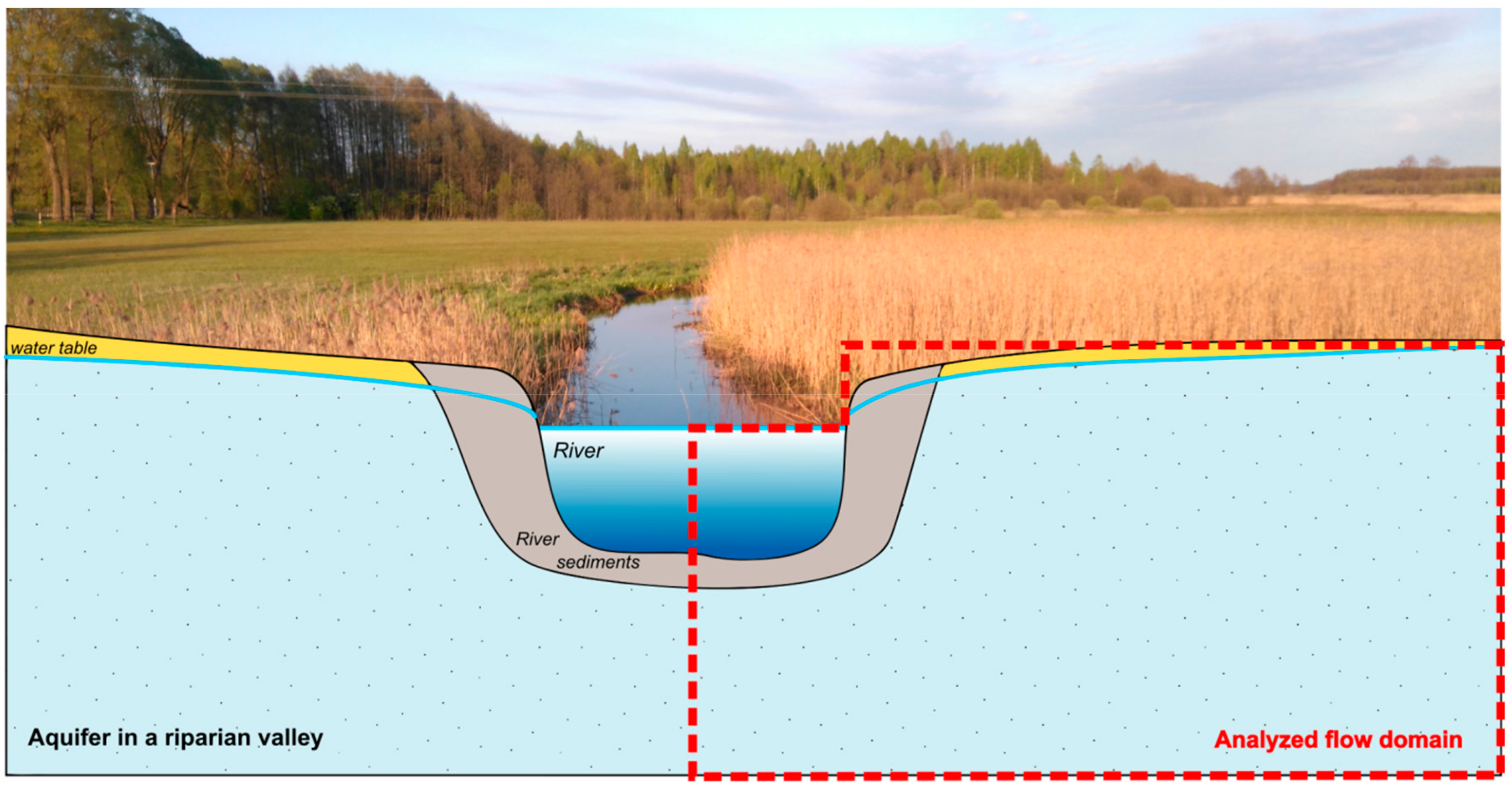
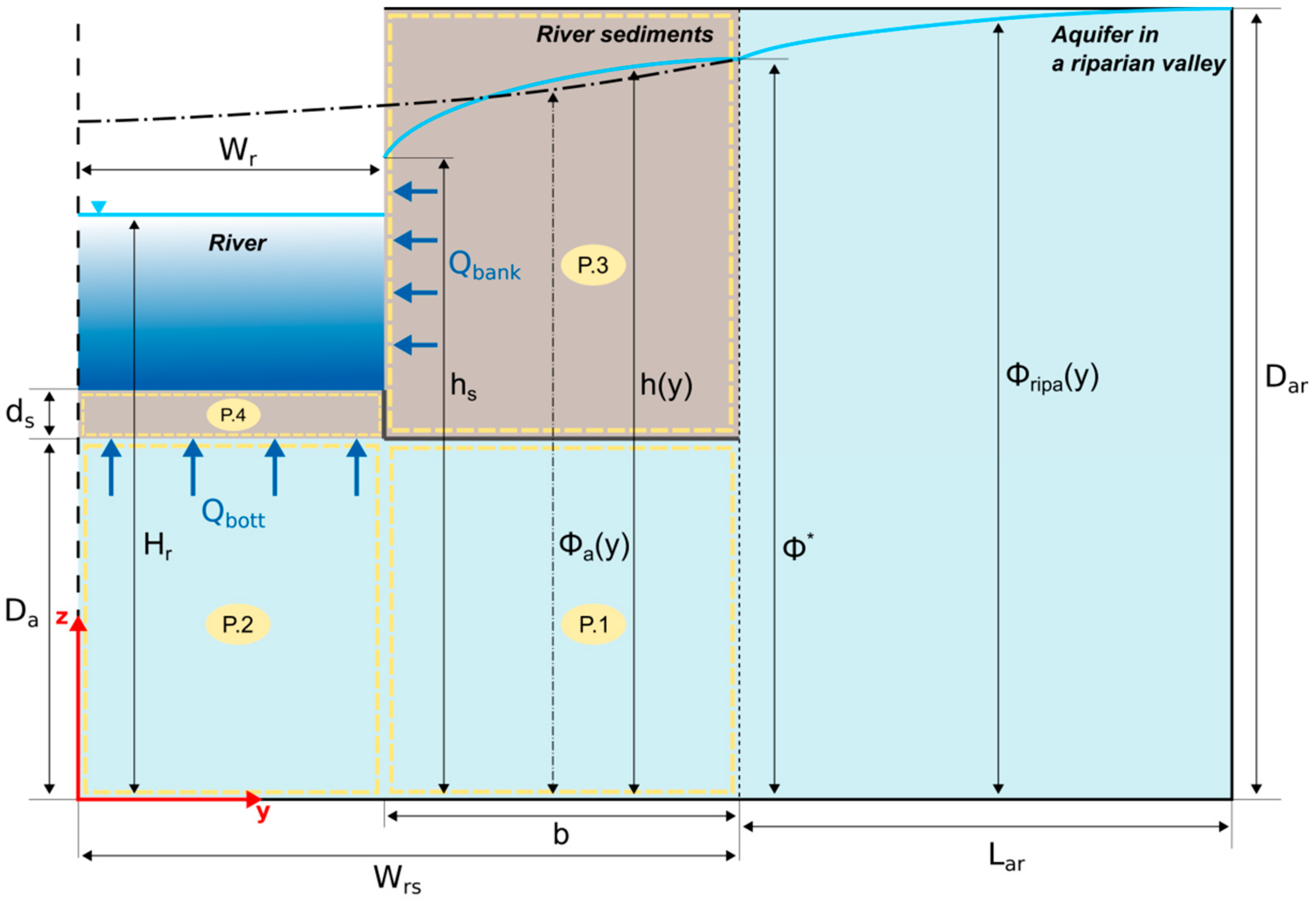

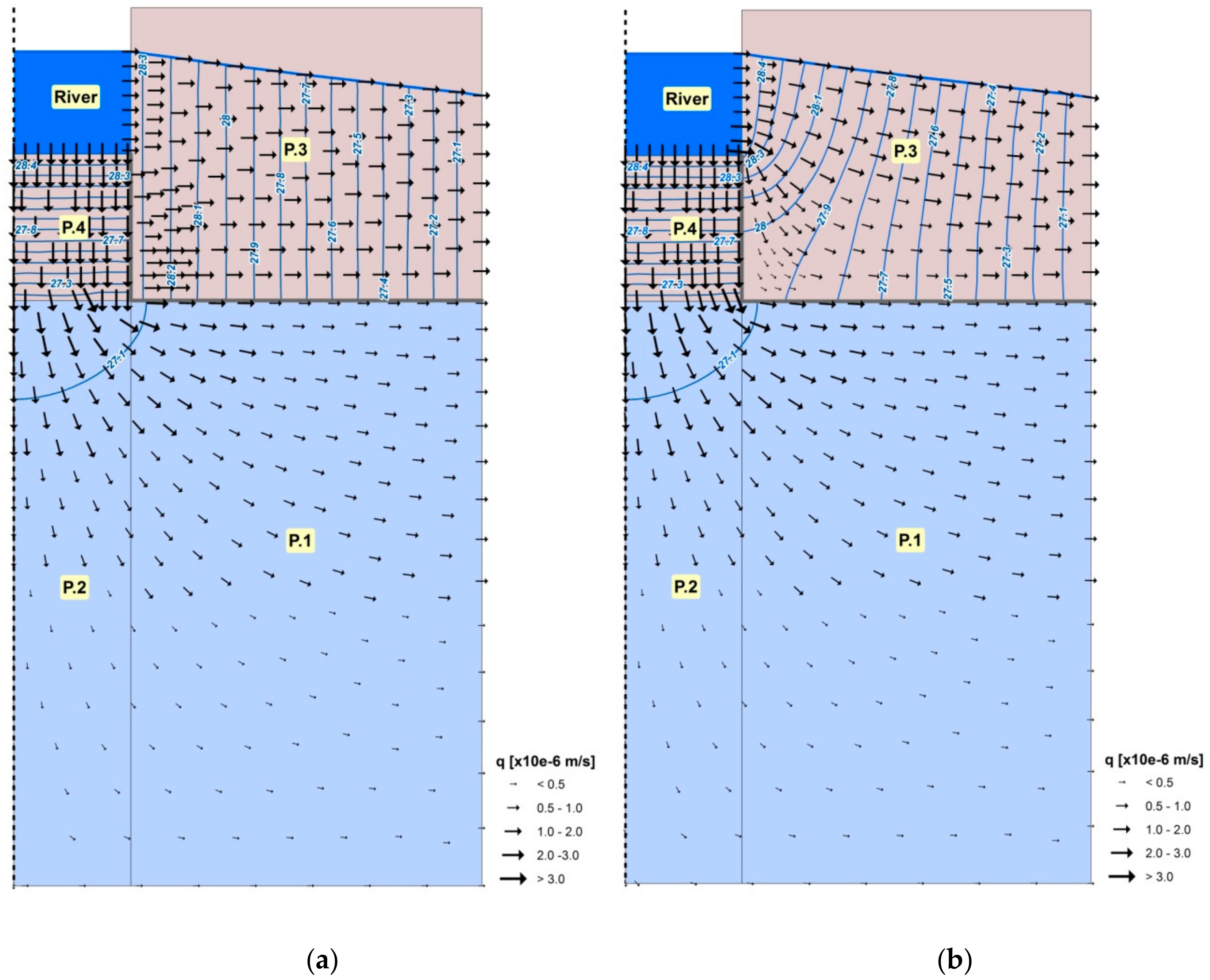
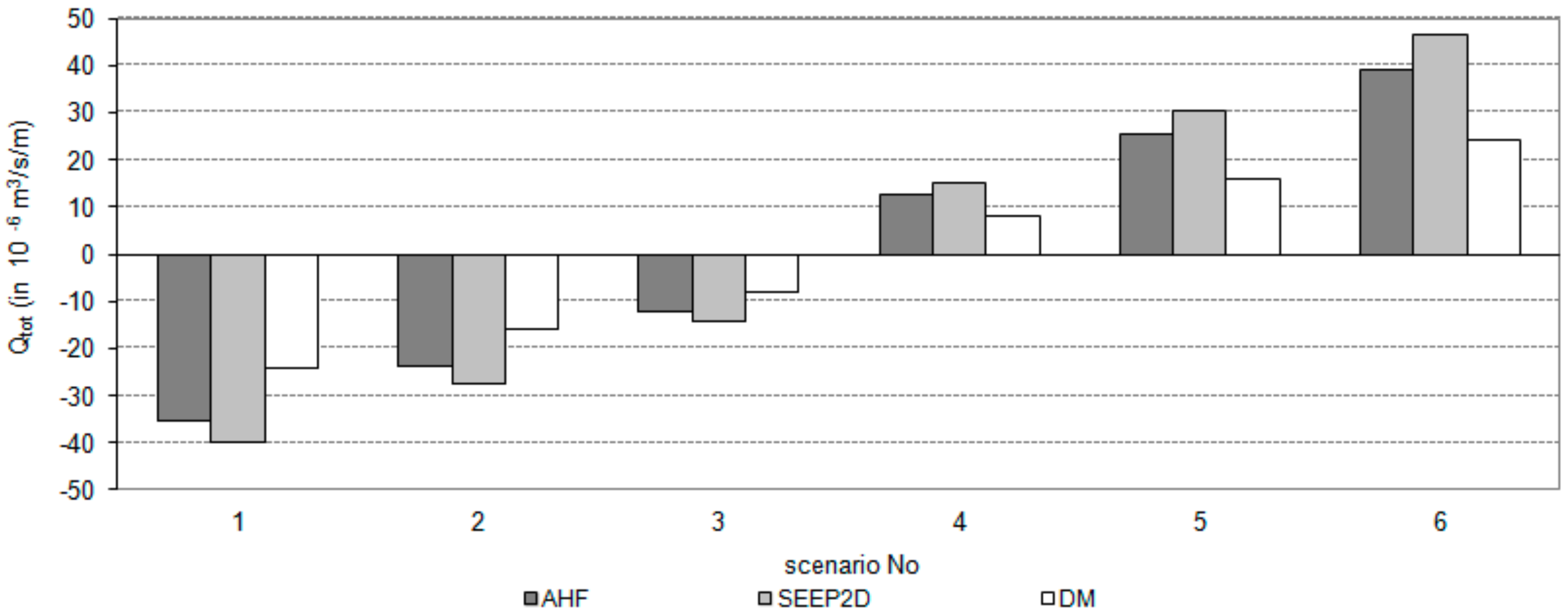
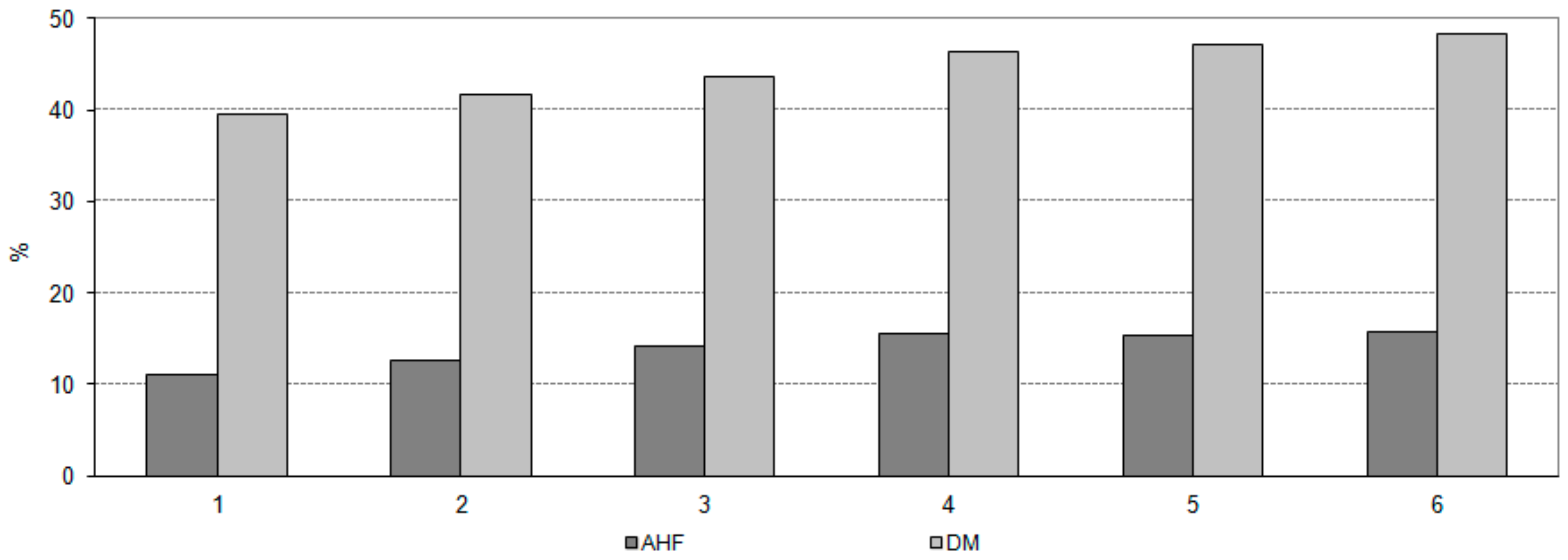
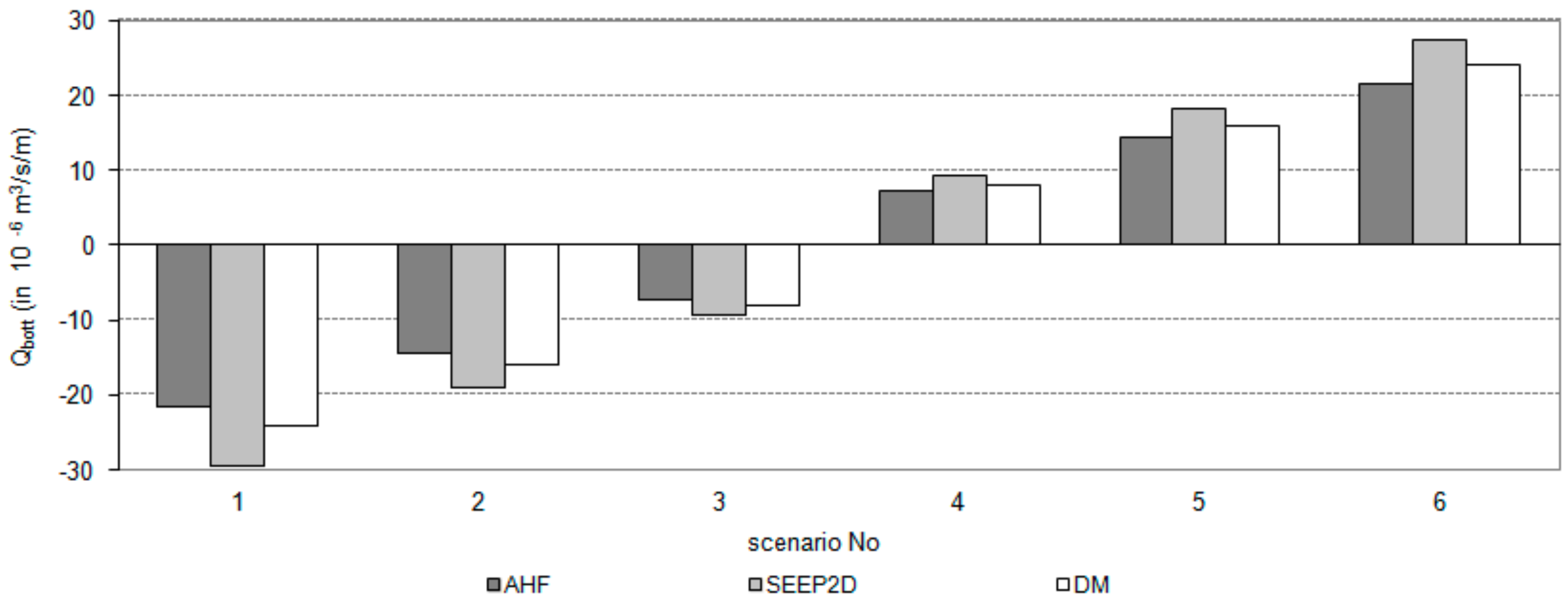
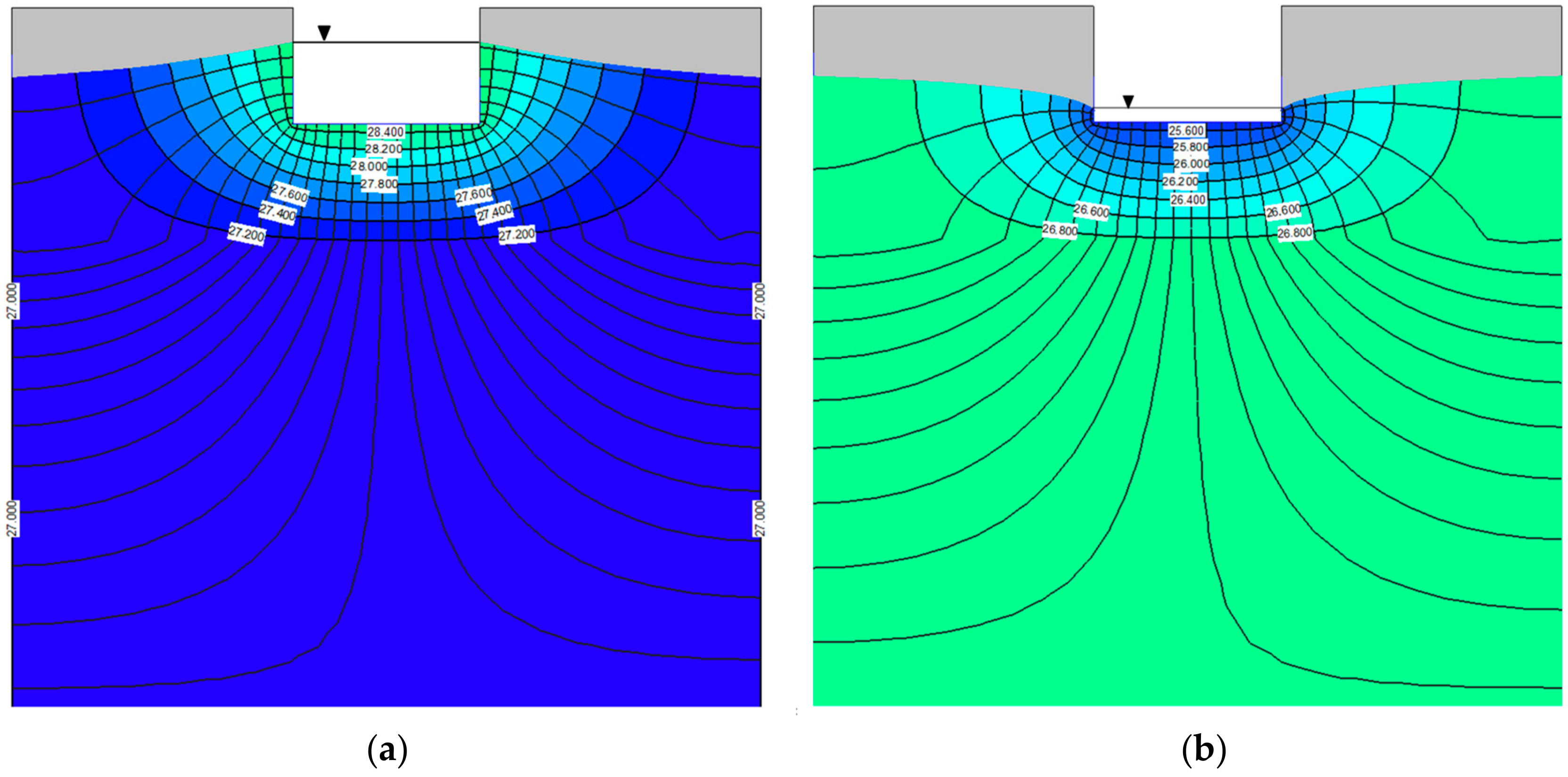

| Variable | Values |
|---|---|
| Da | 20 m |
| ka | 0.000116 m/s |
| Wrs | 16 m |
| Wr | 4 m |
| ds | 5 m |
| ks | 0.00001 m/s |
| Hr | 25.5–28.5 m |
| Φ* | 27 m |
| Scenario No. | Qtot [×10−6 m3/s/m] | B/A | C/A | ||
|---|---|---|---|---|---|
| MESH | |||||
| A | B | C | |||
| 1 | −39.7 | −39.5 | −39.8 | 0.9951 | 1.0027 |
| 2 | −27.4 | −27.3 | −27.6 | 0.9955 | 1.0057 |
| 3 | −14.2 | −14.1 | −14.2 | 0.9956 | 1.0026 |
| 4 | 14.9 | 14.8 | 15.0 | 0.9949 | 1.0026 |
| 5 | 30.3 | 30.2 | 30.5 | 0.9967 | 1.0050 |
| 6 | 46.4 | 46.2 | 46.6 | 0.9961 | 1.0041 |
| Scenario No. | Φ*[m] | Hr[m] | Qbank, Qbott, Qtot [×10−6 m3/s/m] 1 | |||||
|---|---|---|---|---|---|---|---|---|
| AHF | SEEP2D | |||||||
| Qbank | Qbott | Qtot | Qbank | Qbott | Qtot | |||
| 1 | 27.0 | 25.5 | −6.89 | −10.76 | −17.65 | −5.39 | −10.56 | −15.95 |
| 2 | 27.0 | 26.0 | −4.80 | −7.17 | −11.97 | −3.94 | −7.04 | −10.98 |
| 3 | 27.0 | 26.5 | −2.51 | −3.58 | −6.09 | −2.13 | −3.52 | −5.65 |
| 4 | 27.0 | 27.5 | 2.71 | 3.58 | 6.29 | 2.40 | 3.52 | 5.92 |
| 5 | 27.0 | 28.0 | 5.64 | 7.17 | 12.81 | 5.02 | 7.04 | 12.06 |
| 6 | 27.0 | 28.5 | 8.77 | 10.76 | 19.53 | 7.87 | 10.56 | 18.43 |
| Scenario No. | Hr [m] | River Recharge/Discharge through Groundwater Seepage Qtot [× 10−6 m3/s/m] 2 | ||
|---|---|---|---|---|
| AHF | SEEP2D | DM | ||
| 1 | 25.5 | −35.3 | −39.7 | −24.0 |
| 2 | 26.0 | −23.9 | −27.4 | −16.0 |
| 3 | 26.5 | −12.2 | −14.2 | −8.00 |
| 4 | 27.5 | 12.6 | 14.9 | 8.00 |
| 5 | 28.0 | 25.6 | 30.3 | 16.0 |
| 6 | 28.5 | 39.1 | 46.4 | 24.0 |
© 2020 by the authors. Licensee MDPI, Basel, Switzerland. This article is an open access article distributed under the terms and conditions of the Creative Commons Attribution (CC BY) license (http://creativecommons.org/licenses/by/4.0/).
Share and Cite
Nawalany, M.; Sinicyn, G.; Grodzka-Łukaszewska, M.; Mirosław-Świątek, D. Groundwater–Surface Water Interaction—Analytical Approach. Water 2020, 12, 1792. https://doi.org/10.3390/w12061792
Nawalany M, Sinicyn G, Grodzka-Łukaszewska M, Mirosław-Świątek D. Groundwater–Surface Water Interaction—Analytical Approach. Water. 2020; 12(6):1792. https://doi.org/10.3390/w12061792
Chicago/Turabian StyleNawalany, Marek, Grzegorz Sinicyn, Maria Grodzka-Łukaszewska, and Dorota Mirosław-Świątek. 2020. "Groundwater–Surface Water Interaction—Analytical Approach" Water 12, no. 6: 1792. https://doi.org/10.3390/w12061792
APA StyleNawalany, M., Sinicyn, G., Grodzka-Łukaszewska, M., & Mirosław-Świątek, D. (2020). Groundwater–Surface Water Interaction—Analytical Approach. Water, 12(6), 1792. https://doi.org/10.3390/w12061792





